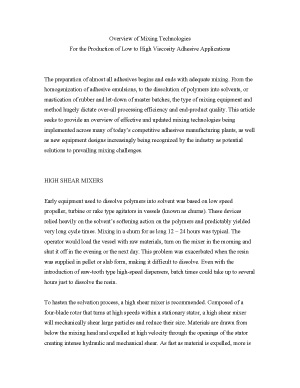Overview of Adhesives Industry Applications
The preparation of almost all adhesives begins and ends with adequate mixing. From the homogenization of adhesive emulsions, to the dissolution of polymers into solvents, or mastication of rubber and let-down of master batches, the type of mixing equipment and method hugely dictate over-all processing efficiency and end-product quality. This article seeks to provide an overview of effective and updated mixing technologies being implemented across many of today's competitive adhesives manufacturing plants, as well as new equipment designs increasingly being recognized by the industry as potential solutions to prevailing mixing challenges.
HIGH SHEAR MIXERS
Early equipment used to dissolve polymers into solvent was based on low speed propeller, turbine or rake type agitators in vessels (known as churns). These devices relied heavily on the solvent's softening action on the polymers and predictably yielded very long cycle times. Mixing in a churn for as long 12 – 24 hours was typical. The operator would load the vessel with raw materials, turn on the mixer in the morning and shut it off in the evening or the next day. This problem was exacerbated when the resin was supplied in pellet or slab form, making it difficult to dissolve. Even with the introduction of saw-tooth type high-speed dispersers, batch times could take up to several hours just to dissolve the resin.
To hasten the solvation process, a high shear mixer is recommended. Composed of a four-blade rotor that turns at high speeds within a stationary stator, a high shear mixer will mechanically shear large particles and reduce their size. Materials are drawn from below the mixing head and expelled at high velocity through the openings of the stator creating intense hydraulic and mechanical shear. As fast as material is expelled, more is drawn into the rotor/stator generator. Polymer particles are thus broken down into smaller and smaller pieces which get easier and easier to dissolve. Fillers too such as fumed silica are dispersed faster with a high shear mixer compared to lower energy devices.
To illustrate, a manufacturer of PVC solvent cements switched to the Ross rotor/stator mixer from a high speed disperser and reduced their cycle time from four hours to just under 45 minutes when PVC pellets are used, and under 30 minutes when the PVC is in powder form.






















































